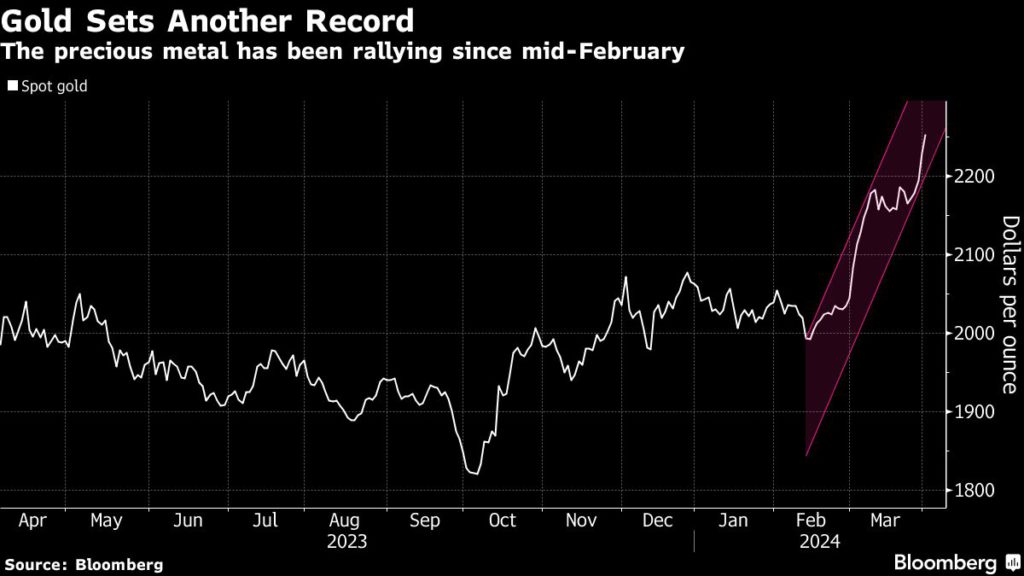Gold price hits another all-time high as Fed-fuelled rally continues

Gold continued its historic rally on Monday by setting another record high, as the latest US inflation data further boosted expectations of a Federal Reserve interest rate cut this coming June.
Spot gold hit an all-time high of $2,265.53 per ounce in the early hours of trading, an increase of 1.6% on Thursday’s closing price, before paring some gains to $2,247.16 per ounce by 8:15 a.m. ET.
Meanwhile, US gold futures shot up 1.2% to $2,265.70 per ounce in New York.

[Click here for an interactive chart of gold prices]
The Fed’s preferred gauge of underlying inflation — the core personal consumption expenditures index — cooled in February, data showed Friday, when many markets were closed. That added to the case for a reduction in borrowing costs, and importantly, for investors to pivot towards the non-yielding bullion.
A host of positive drivers have already pushed up bullion by around 14% since the middle of February. These include the prospect of monetary easing by major central banks and elevated tensions in the Middle East and Ukraine.
There’s also been strong buying by central banks, particularly in China, where consumers have been loading up on the metal amid ongoing problems in Asia’s largest economy. Its central bank has added substantial volumes of bullion to its reserves, boosting holdings in each of the past 16 months.
After the inflation figures, Fed Chair Jerome Powell said the prints were “pretty much in line with our expectations,” and there wasn’t any rush to cut rates. Swaps markets are currently pricing in a 61% chance of a Fed cut in June, up from 57% on Thursday.
Later this week, investors will get a further chance to gauge the outlook for the US economy and central bank policy, with monthly payrolls expected to increase by at least 200,000 for a fourth straight month.
“Inflation data, and Powell’s comments in particular, have provided a further boost to gold, with the market becoming increasingly convinced that the Fed will start to cut rates in June,” said Warren Patterson, head of commodities strategy at ING Groep NV.
However, “it wouldn’t take much of a catalyst to see a pullback in the short term,” and that could be a stronger-than-expected US jobs report, Patterson warned.
No. 1 commodity pick
The metal’s positive prospects have been endorsed by a slew of leading banks.
Among them, JPMorgan Chase said last month that gold was its No. 1 pick in commodities markets, and the price may reach $2,500 an ounce this year. Goldman Sachs Group has said it sees potential for $2,300, highlighting the benefits from a lower interest-rate environment.
“The slightly lower than expected US inflation figure last Friday is supporting the outlook of a mid-year rate cut by the Fed,” said UBS analyst Giovanni Staunovo, in a note to Reuters Monday.
“Markets will now want to see if the payroll data will confirm a soft landing from the job market in the US. Ongoing solid demand is helping the yellow metal as well, although higher prices may weigh on jewellery demand,” Staunovo added.
Still, gold’s ascent has yet to strike a chord among investors who favor exposure to the metal through exchange-traded funds. Worldwide holdings in bullion-backed ETFs shrank by more than 100 tons in the first quarter, hitting the lowest level since 2019 in mid-March, before a small uptick, according to a Bloomberg tally.
(With files from Bloomberg and Reuters)
More News
{{ commodity.name }}
{{ post.title }}
{{ post.date }}



Comments